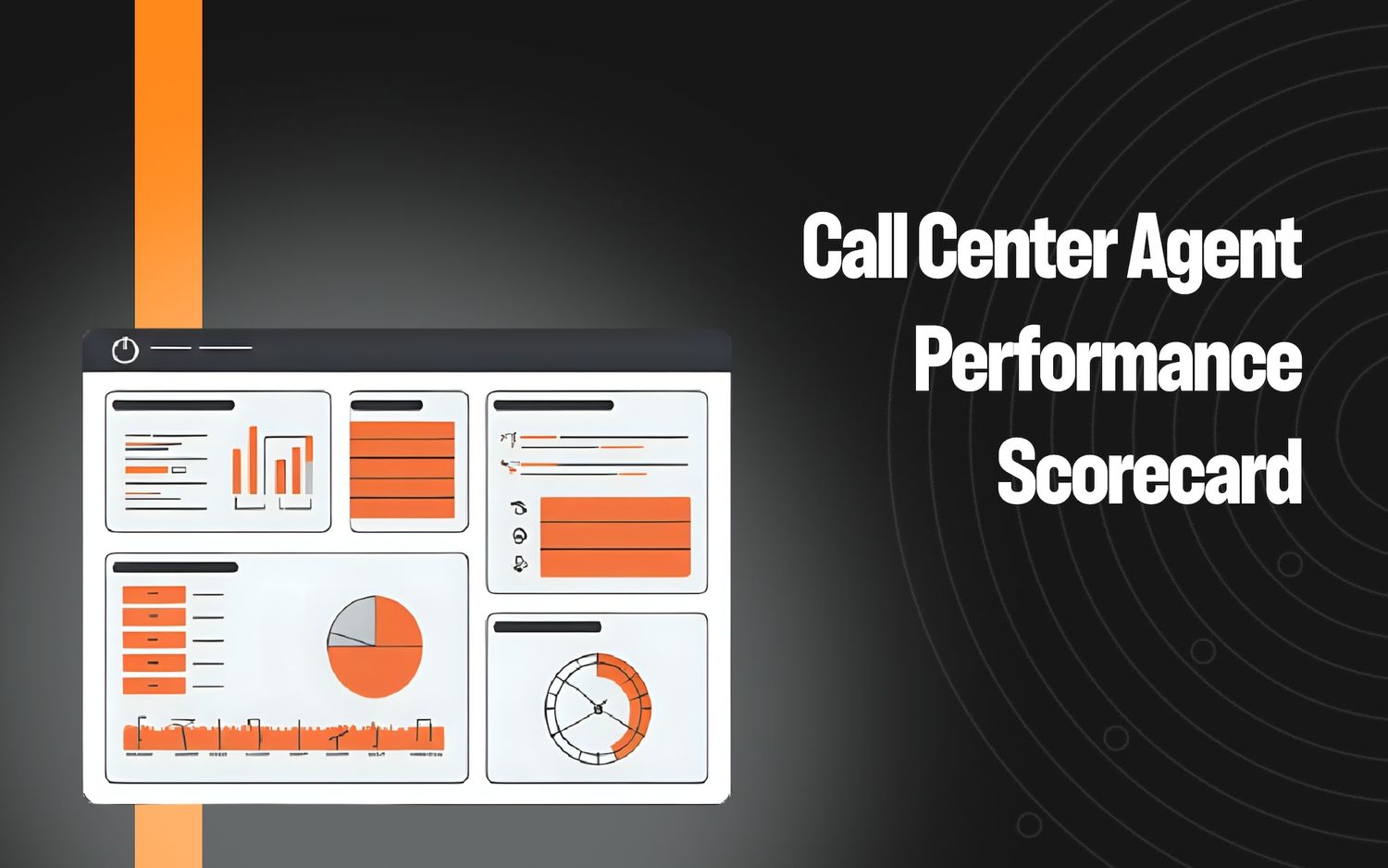Customer Satisfaction Software: 12 Top Products

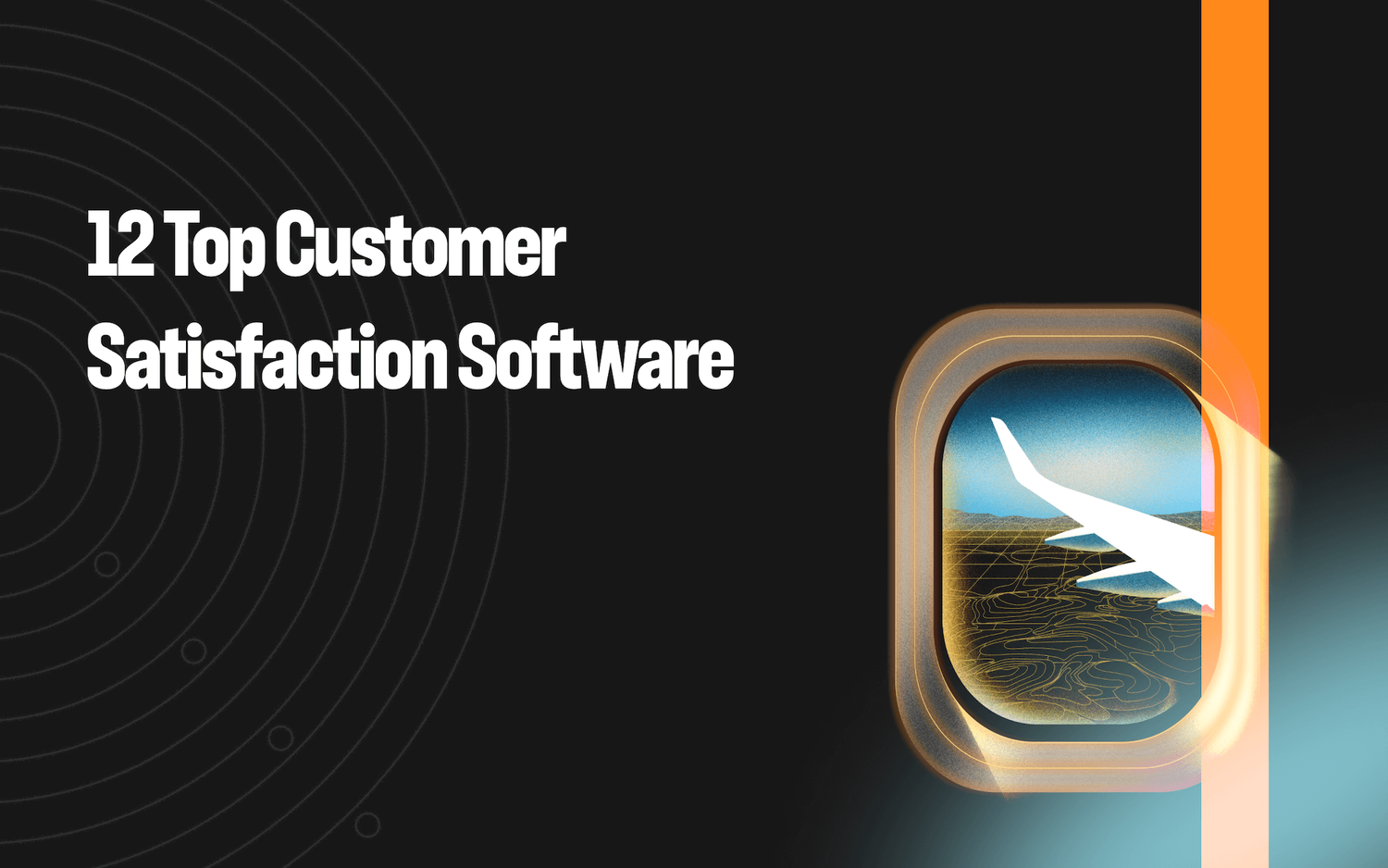
Customer satisfaction software helps companies gather and analyze data related to customers’ opinions and feelings about the company, from their products and services to interactions with customer support.
The goal is to identify opportunities to improve customer experience, increase sales, prevent high churn rates, and increase brand loyalty.
There are different types of customer satisfaction software and the one you choose will determine both how you’re able to gather data and the quality of that data.
For example, if you choose an online survey tool, not all your customers will respond, so you may be working with incomplete data.
The most common types of customer satisfaction software tools are:
- (Traditional) survey tools, which are commonly thought of as best-fit for measuring customer satisfaction, but are becoming outdated thanks to AI.
- Session recording and heatmap tools, which are helpful for marketing and product teams who want to know how customers are interacting with their website and products, but aren’t the best fit for figuring out what your customers think and feel about their interactions with your company.
- Customer experience software, which is an effective solution for uncovering customers’ perceptions and feelings when they reach out to customer support.
In this guide, we’ll cover the pros and cons of each type of tool and then share software options for each one. We’ll start the list with Level AI, our own solution offering secure and customizable Generative AI capabilities for contact centers.
Pros and Cons of Different Types of Customer Satisfaction Software (and How to Choose)
Survey Tools: An Incomplete Picture of Customer Interactions
Survey tools are the most common way to measure customer experience and identify opportunities to improve it.
But are they still the best way to measure customer satisfaction?
On the one hand, they’re easy to set up and run. Some of the more advanced survey tools can streamline workflows for sending out and analyzing surveys. For example, they can automatically send out surveys at specific touchpoints, integrate with other sources of data, like ticketing systems, and analyze submitted responses.
On the other hand, even survey tools with advanced functionality can’t give you a complete picture of customer satisfaction because they rely on customers to submit responses. This means that:
#1: You typically only see responses from extremely happy or unhappy customers.
Unless they’re extremely happy or dissatisfied, customers aren’t motivated to spend their time on responding to surveys, so companies don’t get a full picture of customer experiences.
#2: You may get biased and incomplete answers from respondents.
Customers often forget details or decide they’re not worth adding to their response. For example, customers that leave a positive customer satisfaction score (CSAT) may have decided to overlook some of the annoyances along the way. Even if you add open-ended questions to your surveys, you likely won’t know the full story of their experience or the real reasons why they responded the way that they did.
#3: You don’t know what you don’t know.
With surveys, you have to determine what to ask about ahead of time. So, if an issue hasn’t come to your attention before, you won’t know to ask about it. Even if you include a section where customers can leave comments about whatever they want, most customers won’t necessarily provide these (or won’t give enough detail to be helpful). There will still be issues that you don’t realize exist.
Session Recording and Heatmap Tools for Product & Marketing Teams
Tracking website visitors’ and users’ behavior can help solve multiple user experience challenges across the customer journey. For example, you can:
- Uncover where people get frustrated as they interact with the product or the website.
- See where visitors lose interest and stop scrolling down the page or leave the website.
- Find on-page or UI elements that don’t feel intuitive, and more.
While these tools help marketing and product teams understand how prospects and customers interact with their website and products, they don’t tell you how they’re experiencing the interaction.
Many session recording and heatmap tools include surveys as well, but those have all the same limitations mentioned above.
Customer Experience Software: Direct Insights into 100% of Customer Interactions
While surveys rely on customers to voluntarily provide feedback on their interactions with the customer success (CS) team, customer experience software tracks every call and text-based interaction that your customers have with your company, analyzing the results and reporting what it finds.
This means data on customer experiences is gathered from every conversation, which is markedly better than collecting data from a few who are willing to fill out a survey.
When it comes to CX software, however, it’s important to remember there are two types: rule based and AI powered.
Most rule-based speech analysis tools rely on keywords to detect issues mentioned on the calls but don’t necessarily grasp the meaning behind the words. So their analysis is less precise, potentially leading to misinterpretations across customer interactions.
For example, such tools may lump together “I want to return this dress because you sent me the wrong one” and “I want to return this dress because it doesn’t fit,” even though the reasons for the returns are different.
Additionally, keyword-based tools won’t classify a call correctly if they detect a phrase that’s not already on the list.
For example, if you’ve set up the tool to categorize phrases that include “send it back” and “return” in the same bucket, but a customer uses another expression like, “I mailed it back and want a refund,” that instance may be missed or possibly categorized incorrectly.
To avoid such kinds of inaccuracies, you may end up predefining tens or even hundreds of keyword combinations. Even then, there’s no guarantee customer intent will always be correctly captured.
Another important difference is that rules-based tools don’t necessarily understand the underlying context of the conversation and therefore may not detect subtleties, like sarcasm.
AI-powered speech analytics tools, on the other hand, are much more capable of grasping the overall situation and intents that customers are expressing — they can understand the “why” behind any given statement.
How is this? We’ll describe more on this in the sections below.
In sum, AI-driven customer experience software gives you:
- Insights into 100% of customer interactions.
- An ability to detect trends you may not have been aware of.
- Conversational intelligence for both past and live conversations.
Below, we present a variety of different customer satisfaction software options.
1. Level AI: Customer Satisfaction Software for Analyzing 100% of Customer Interactions in Real Time
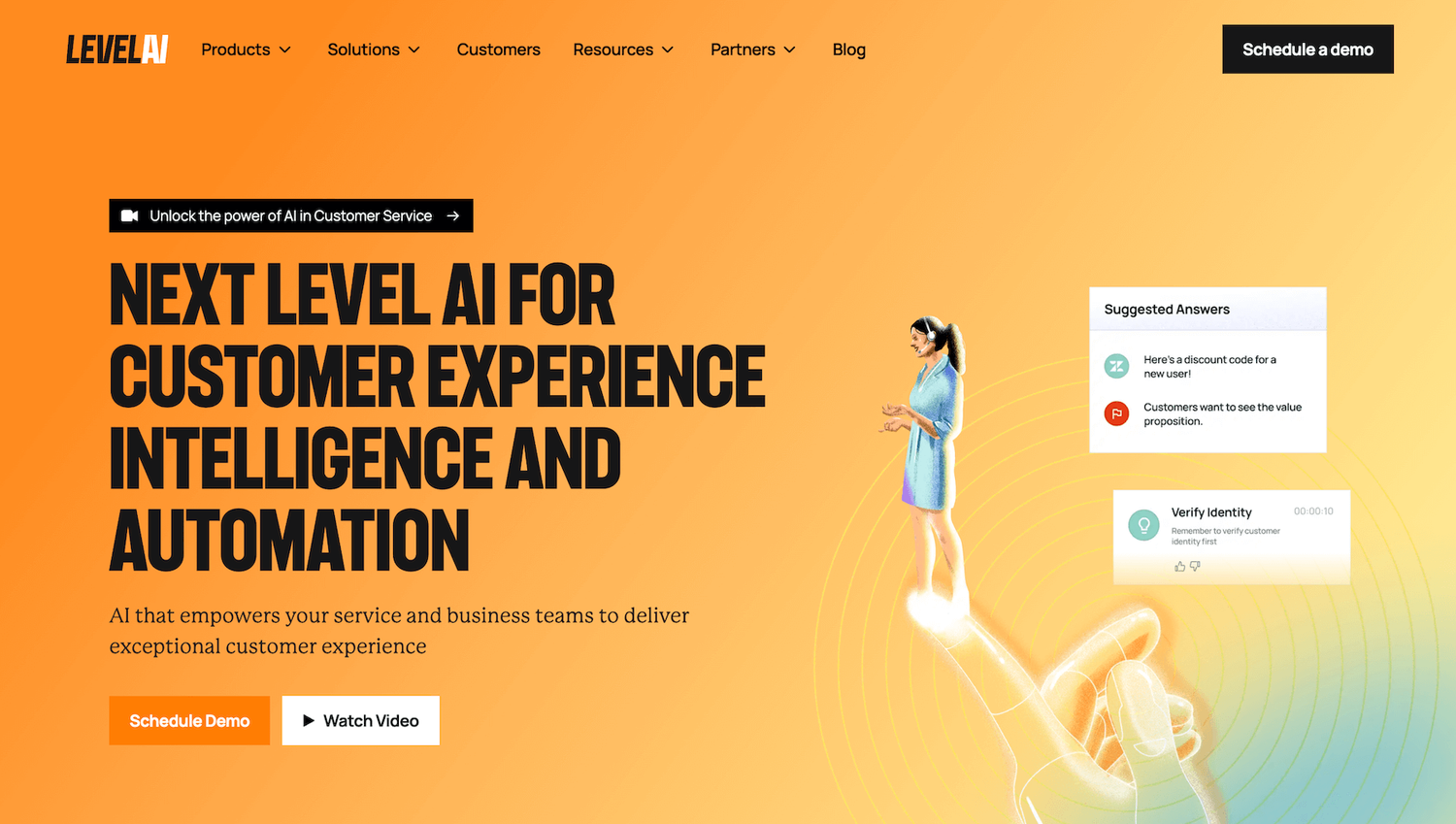
Level AI is AI-powered customer experience software that detects a wider array of sentiments than any other solution available, and offers customizable dashboards for automated quality management, which can be readily integrated with almost any tool you need.
We serve companies in industries that include financial services, retail, healthcare, insurance, and more. Our software helps them improve CSAT, time to resolution, customer loyalty, and CX.
Here are a few examples:
- A provider of contact center support for financial companies used Level AI to quantify and categorize customer calls to build a complete picture of customer interactions. Thanks to that analysis, the product team identified use cases where they could develop self-serve solutions for customers. Based on the company estimates, deflecting those calls led to over $3 million in annual savings.
- An insurance provider offered real-time guidance and support to contact center agents with Level AI to reduce average handle times by 20%, and increase First Call Resolution rates by 15%.
- An e-commerce company set up a Salesforce integration with Level AI to minimize the number of touchpoints required to satisfy customer inquiries and reduce the amount of manual work for agents. This led to a 75% decrease in after-call work for agents.
In the following sections, we dive into how we help companies understand their customers' opinions and feelings, uncover trends they wouldn’t have detected otherwise, and resolve issues before they escalate.
Understanding Customer Opinions and Sentiments
Level AI uses natural language understanding (NLU) and semantic intelligence to analyze and understand voice interactions between customers and agents.
This allows it to recognize both intent behind the words (or the reason for the call) and the emotions (or sentiments) displayed by customers during the call — without you having to enter any keywords or set up any rules for it to follow.
To make it easier to search for similar conversations and analyze them, Level AI’s Scenario Engine classifies intents expressed throughout the conversation as scenarios and labels these using conversation tags at relevant points throughout the conversation. This provides immediate visibility of key themes during a conversation without having to read every line of the transcript.
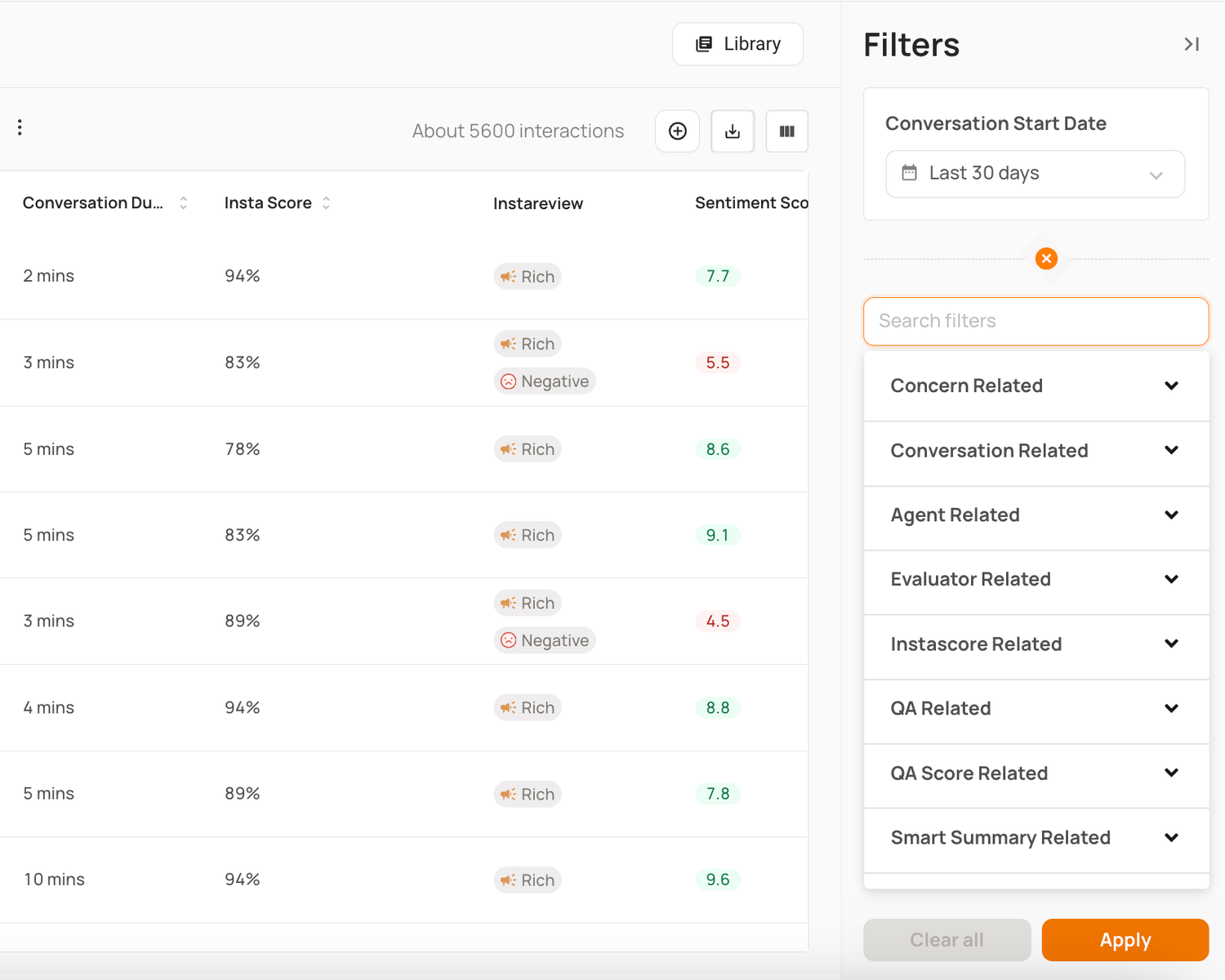
Having conversation tags denoting specific intents in a conversation means you can search for them and create curated lists of similar conversations. For example, you could search for all calls dealing with setup issues.
In terms of sentiment analysis, Level AI can detect emotions including anger, disapproval, disappointment, worry, happiness, admiration, and gratitude. Like conversation tags, Level AI labels different points in the conversation where these sentiments show up with sentiment tags.
It also summarizes the overall sentiment that customers experience during a call by assigning a sentiment score to the conversation, which is a score from 0 to 10. 0 marks the most extreme negative sentiment and 10 reflects the highest positive emotions.
Level AI assigns higher weight to the emotions at the end of the call due to the fact that customer feelings after an issue has been resolved (or not) more accurately reflects how they feel about your product or service overall.

Uncover Trends with Voice of the Customer (VOC) Insights
Level AI’s VoC Insights automatically tracks standard customer satisfaction metrics like CSAT. It can also uncover trends that may have previously gone unnoticed.
Unlike surveys, there’s no manual effort involved in Level AI’s VoC data and the results capture 100% of customer experiences.
VoC data is presented in intuitive dashboards offering a holistic view of customer satisfaction, performance trends, and recurring issues:
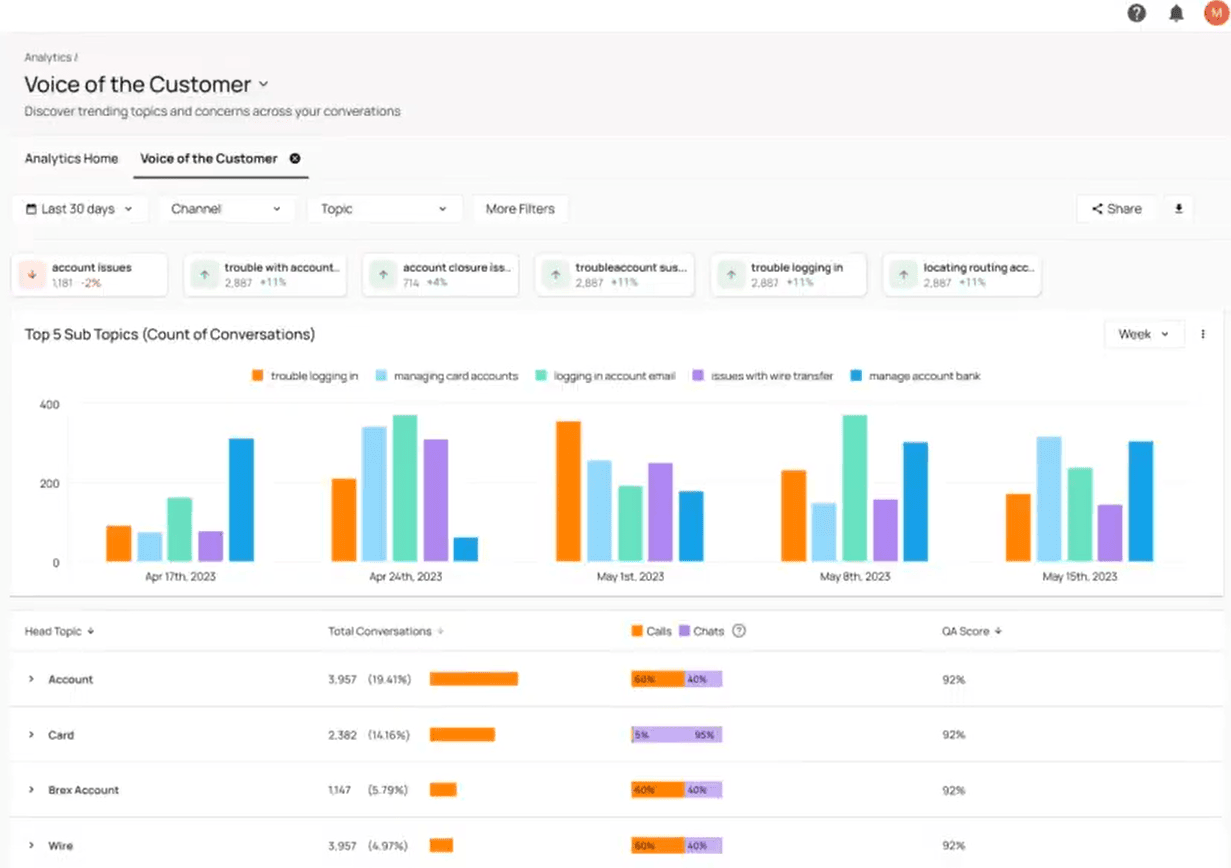
Level AI automatically tracks the frequency of scenarios and sentiments, and alerts you to any gathering trends. Here are some examples of patterns that VoC might uncover:
- Recurring instances where customers express confusion about pricing or billing details.
- An uptick in complaints tied to changes in product packaging or delivery timelines.
- Increases in requests for self-service options for commonly reported issues.
- Frequent mentions of a specific competitor during conversations, indicating competitive pressure or customer comparisons.
Identifying such trends can help you find new ways of improving the customer experience and improving QA.
Analyzing Customer Interactions and Improving CX Through Reporting Insights
Level AI’s flexible analytics dashboard integrates data from across your organization to help you detect patterns in the customer experience or agent performance, and visualize overall trends.
You can build your own reports and analytics dashboards using Level AI’s Query Builder, which accepts a wide variety of data types and formats.
The Query Builder lets you combine data from Level AI — allowing you to report against customer sentiment, agent performance, topics discussed during interactions, and more — with external data such as CRM records, sales data, or support ticket details.
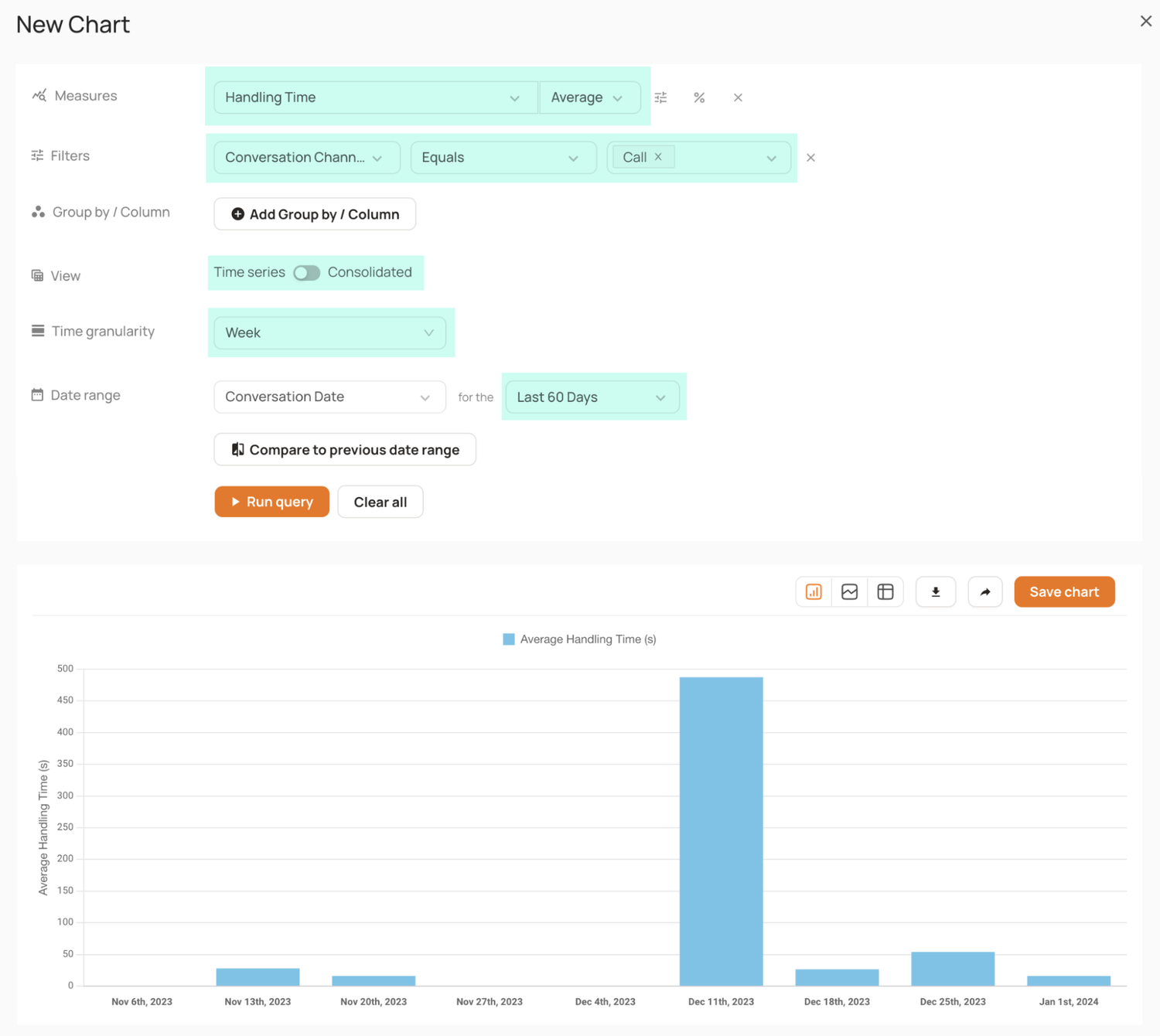
This results in intuitive analytics dashboards that provide a big picture view of customer interactions and let you identify insights, monitor key performance indicators, and uncover opportunities for improving the customer experience.
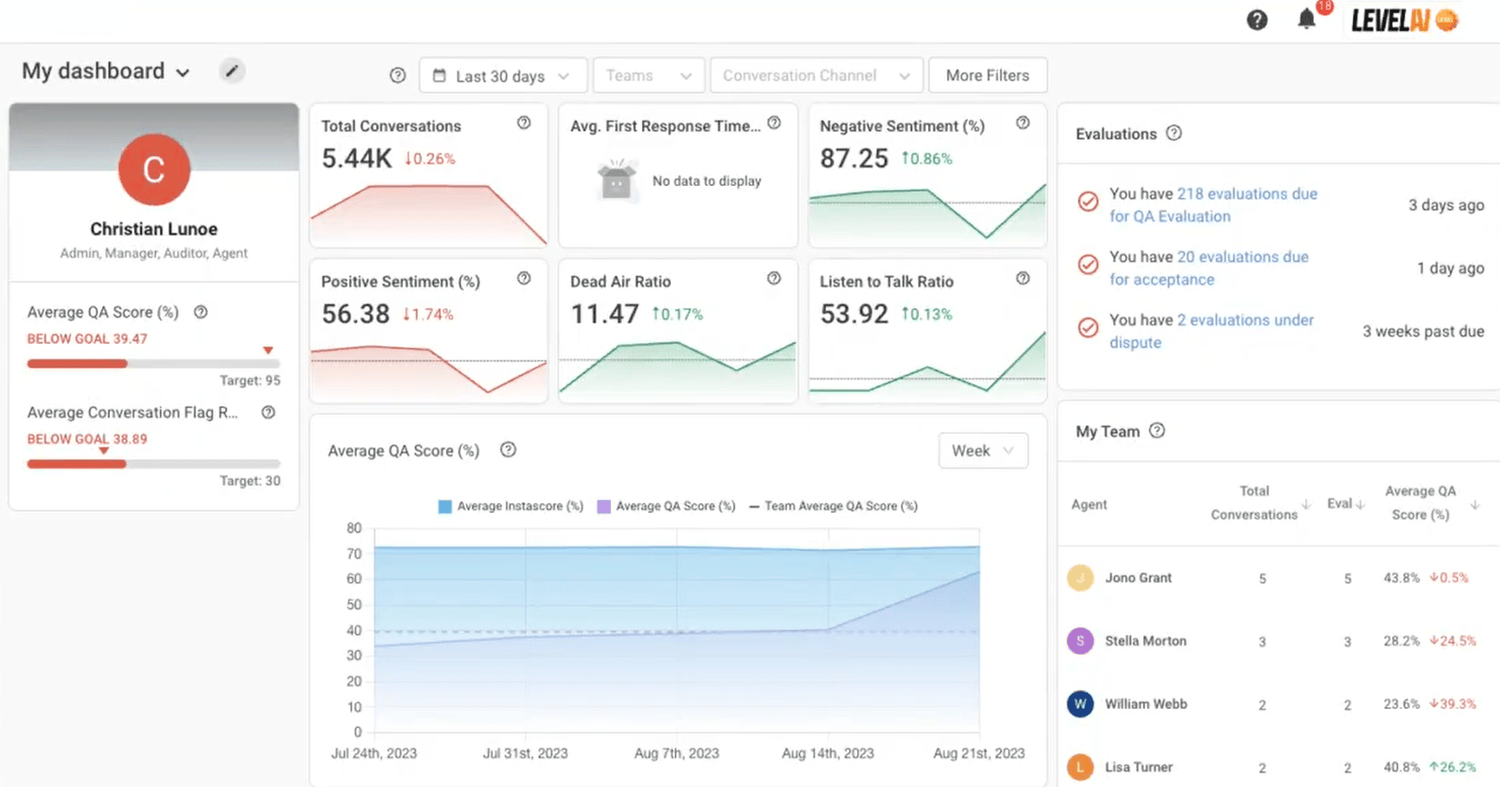
The ability to unify data across tools and silos into a single view can reveal trends and correlations across channels, and allow you to ask fascinating questions such as:
- Do interactions across phone, email, etc., show varying levels of customer satisfaction depending on the topic discussed (for example, billing inquiries vs calls about technical difficulties)?
- Which topics are linked to higher agent performance across different support channels?
- Which product features are associated with the highest levels of customer dissatisfaction?
- What patterns in customer interactions precede churn or account cancellations?
- Do customer sentiments tend to shift during longer interactions?
This Level AI customer set up a custom dashboard to track and compare NPS for conversations about technical issues to understand how platform challenges affected customer satisfaction, and to prioritize feature updates accordingly. Acting on those insights helped reduce customer churn by 27%.
Proactively Helping Agents Resolve Calls Faster and Managers to Provide Support When Needed
Level AI also analyzes customer conversations in real time to help support and sales teams resolve issues during calls:
- Real-Time Agent Assist allows agents to deliver an outstanding customer experience through in-call prompts and tips.
- Real-Time Manager Assist alerts managers when they need to step in to support agents, with minimal disruption to ongoing calls.
Both these features are part of Level AI Agent Copilot, which integrates seamlessly with other products offered by the platform.
Real-Time Agent Assist
Unless they already know the answer, agents find it challenging to find relevant information while on live calls.
Real-Time Agent Assist analyzes conversations as they unfold and pulls from a variety of sources to support agents by displaying a live feed consisting of:
- Actionable hints, FAQs, next steps, and agent scripts
- Help articles from your knowledge base
- Advanced search functionality (i.e., AgentGPT — more on that below)
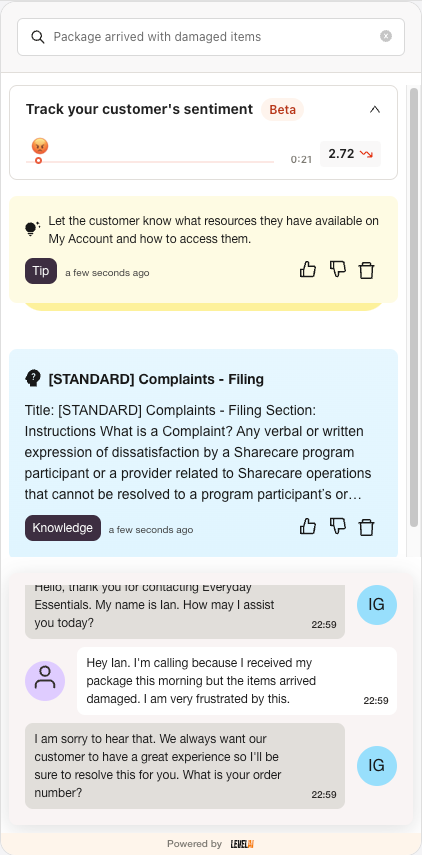
Displaying the right resources at the right time helps agents reduce time to resolution and minimize call escalation, resulting in higher customer satisfaction.
Real-Time Agent Assist’s search feature is powered by AgentGPT, an intelligent knowledge retrieval system that integrates directly with your knowledge base.
By analyzing conversation intent in real time, it suggests and auto-fills relevant search queries, allowing agents to quickly access accurate information without manual effort.
Agents can refine the system’s accuracy by rating the relevance of results, enabling the AI to deliver increasingly precise responses over time. Additionally, it supports seamless transitions from chatbots to live agents, ensuring smooth customer service workflows.
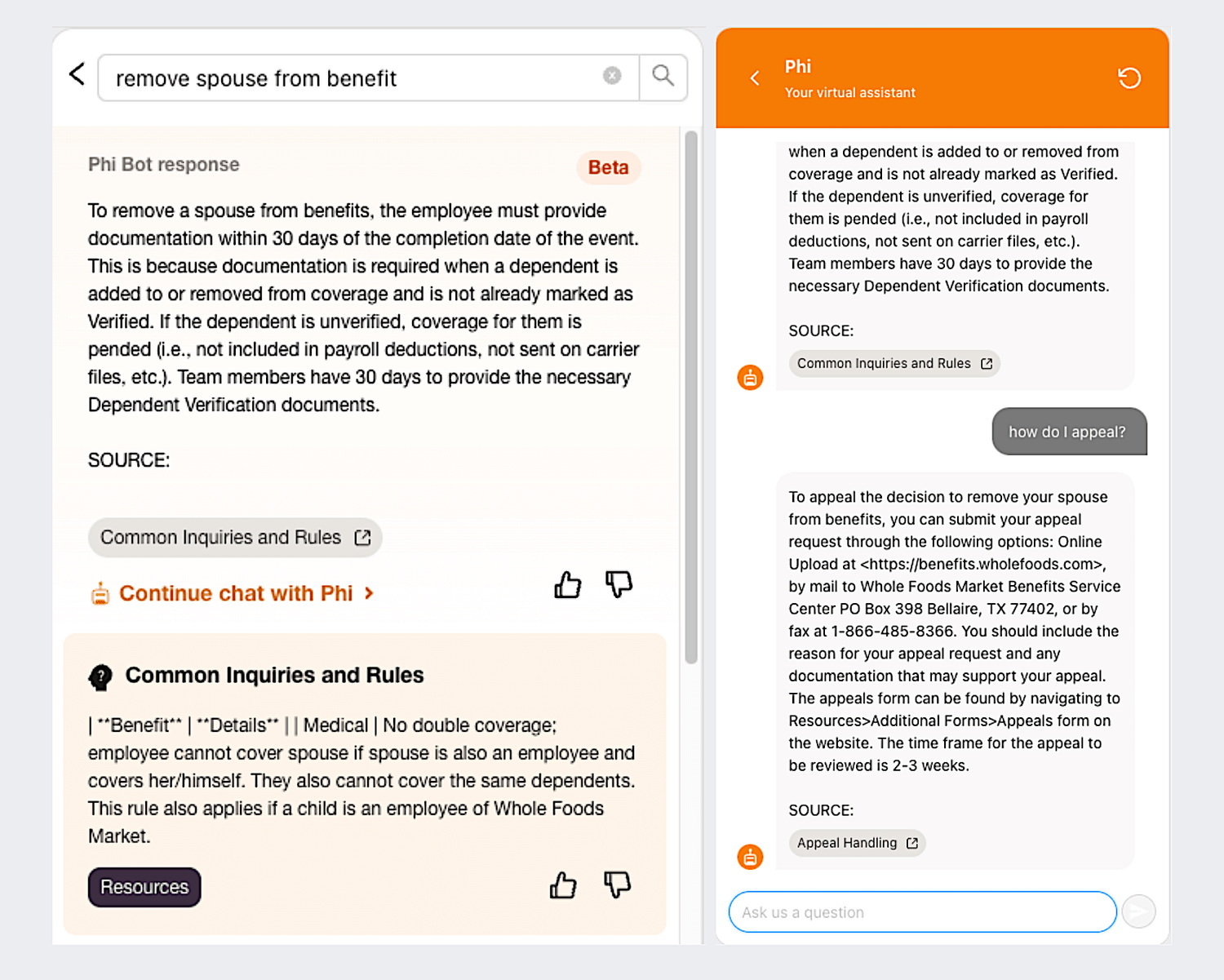
Real-Time Manager Assist
Many call monitoring tools alert supervisors about potential issues with live calls based on metrics, like longer-than-average duration.
Such metrics may indicate a potential problem but don’t provide context about the quality of the interaction or whether the customer’s issue is being effectively addressed.
Real-Time Manager Assist proactively identifies calls requiring escalation by analyzing customer intent and sentiment in real-time. By providing a dashboard featuring live sentiment scores, conversation summaries, and key metrics, it enables timely and informed interventions to improve call outcomes.
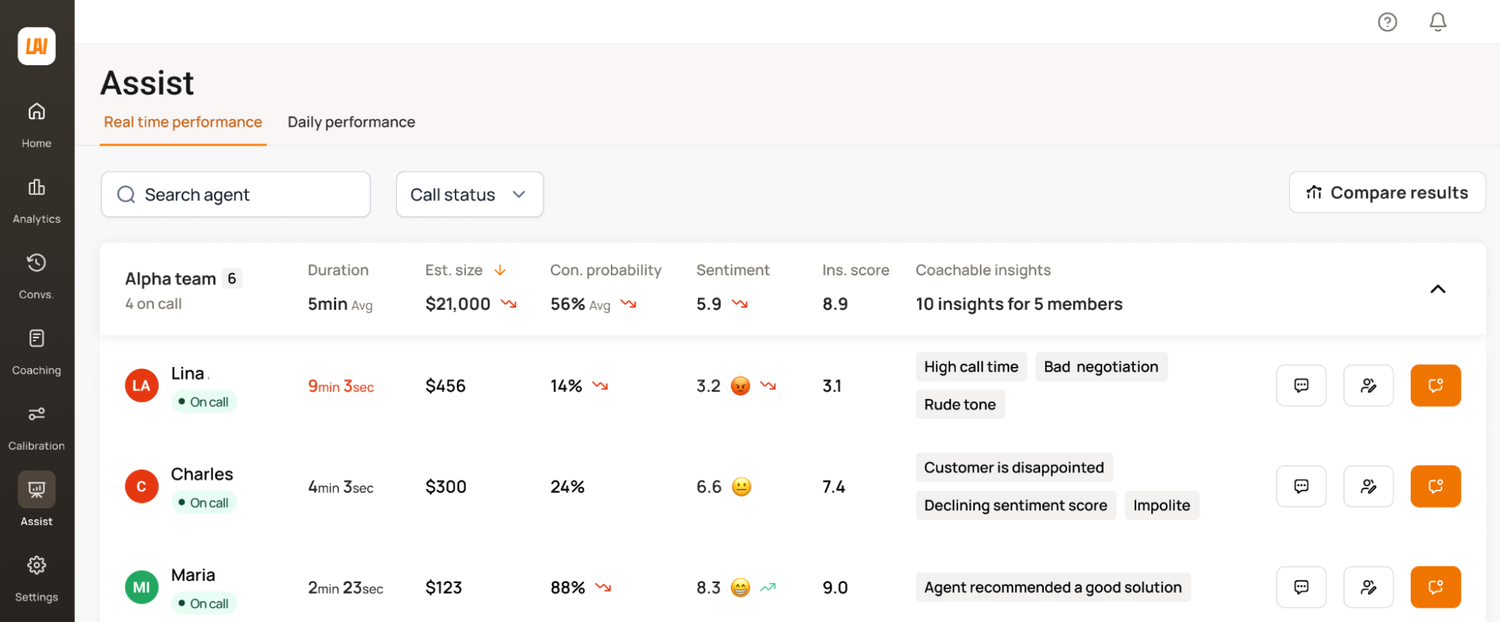
Clicking on any of the displayed metrics brings up linked details and evidence behind the calculation of the score — such as highlighted portions of the real-time transcript relating to a low sentiment score on one of the conversations.
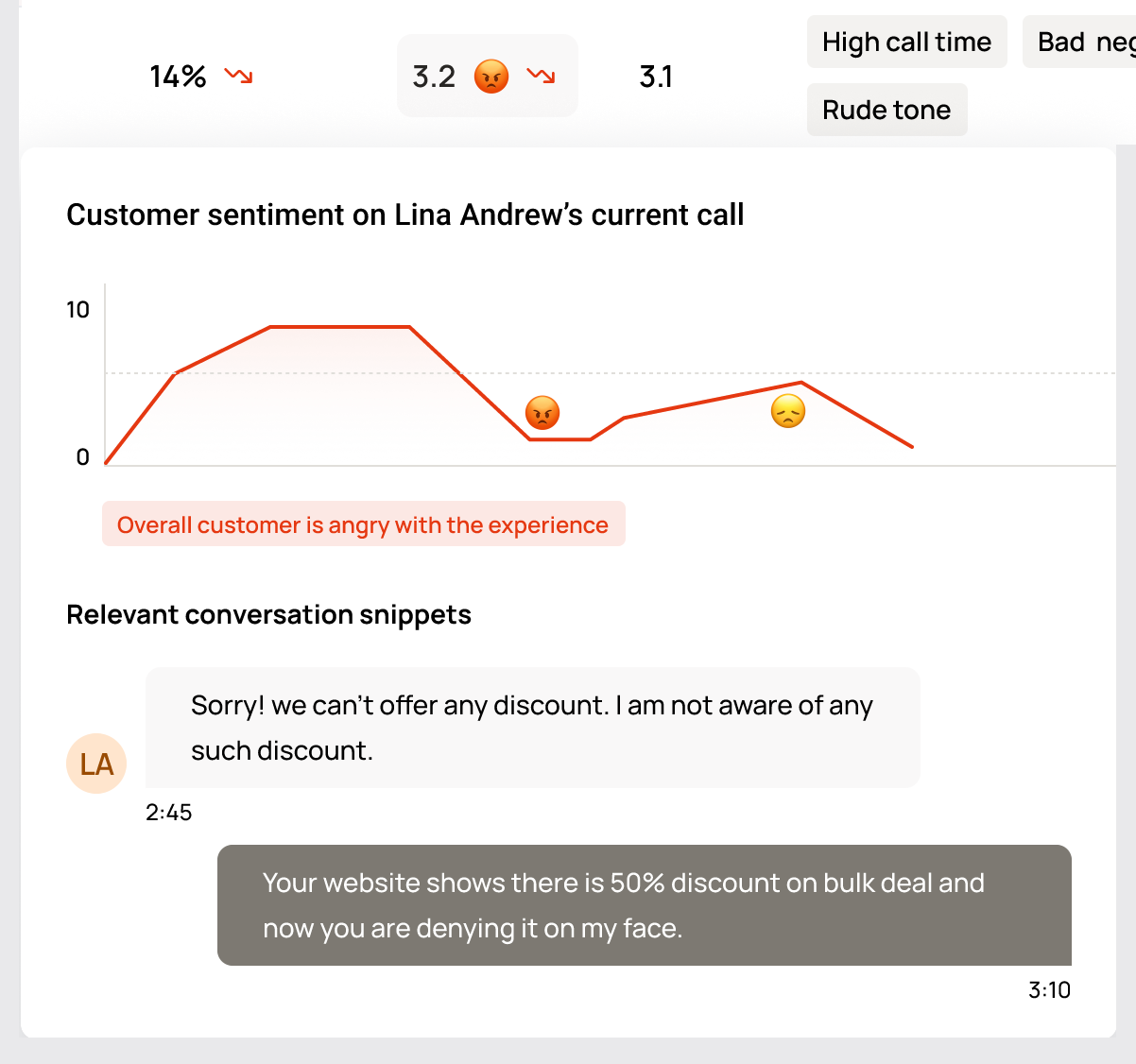
If you decide to intervene, you can use either call whispering to coach the agent or have the call escalated directly to you to address the issue immediately.
The context provided by Level AI’s live dashboard minimizes the time needed for you to know the details of the call, enabling you to take swift and informed action to resolve the issue effectively.
Discover Level AI’s Customer Satisfaction Tools
Level AI’s advanced analytics goes beyond traditional metrics to uncover the reasons why customers are reaching out, and provides actionable insights for contact centers to improve their experience and resolve issues more effectively.
Get in touch with us to learn how our platform can help drive satisfaction, loyalty, and business growth.
Below is a list of alternative customer satisfaction tools to consider for customer service, product, and marketing teams:
2. HubSpot
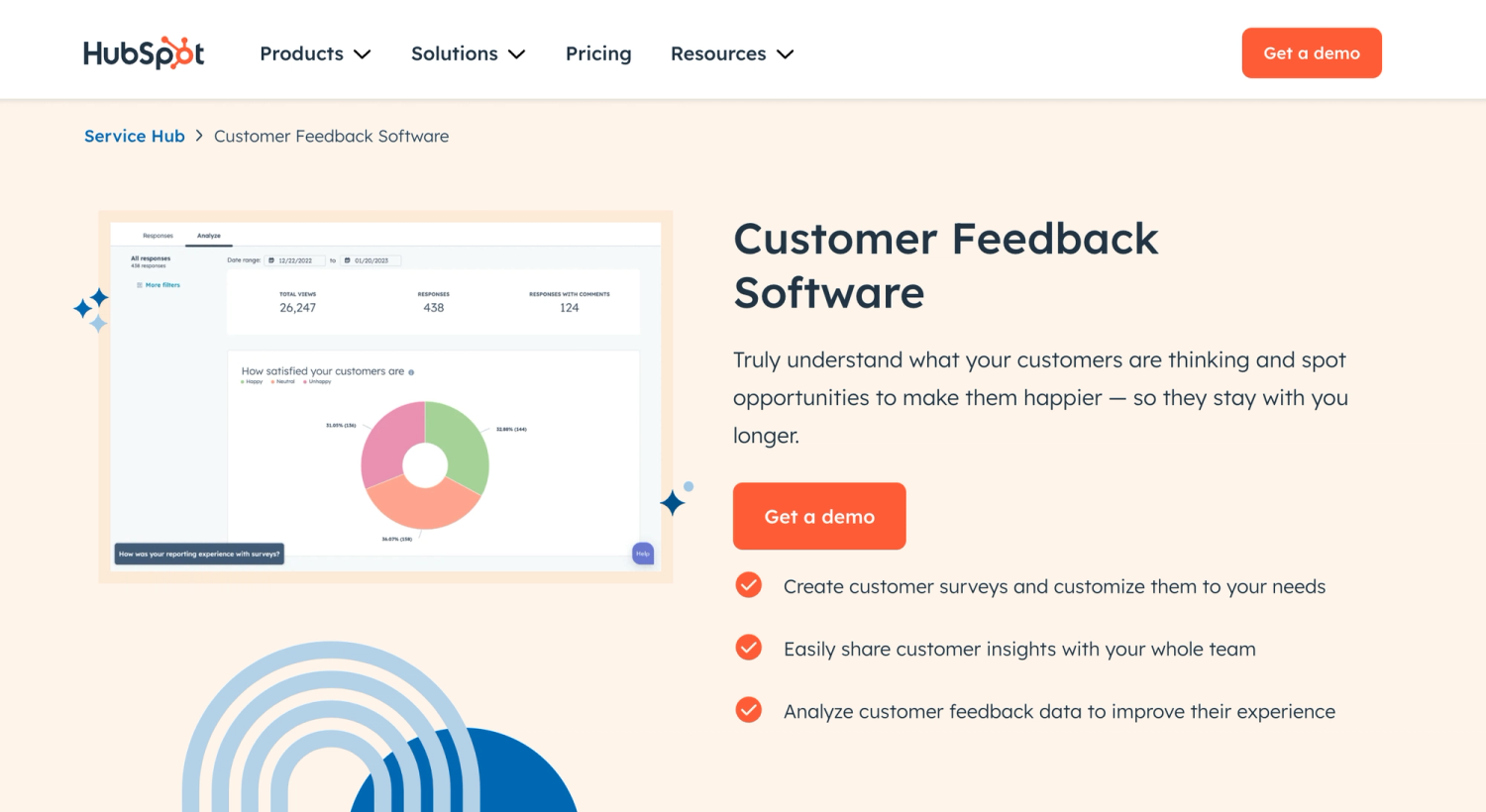
HubSpot offers a customer feedback survey tool as a part of the Service Hub platform that also includes ticketing, messaging, call tracking, helpdesk and more.
Service Hub customer feedback features include:
- Customizable survey templates and feedback collection tools for actionable insights
- Automatic survey triggers for ongoing feedback collection
- Playbooks, service portal, and customer analytics
HubSpot’s Service Hub plans start at $90 per month per seat when billed annually, plus the onboarding fee.
3. Contentsquare
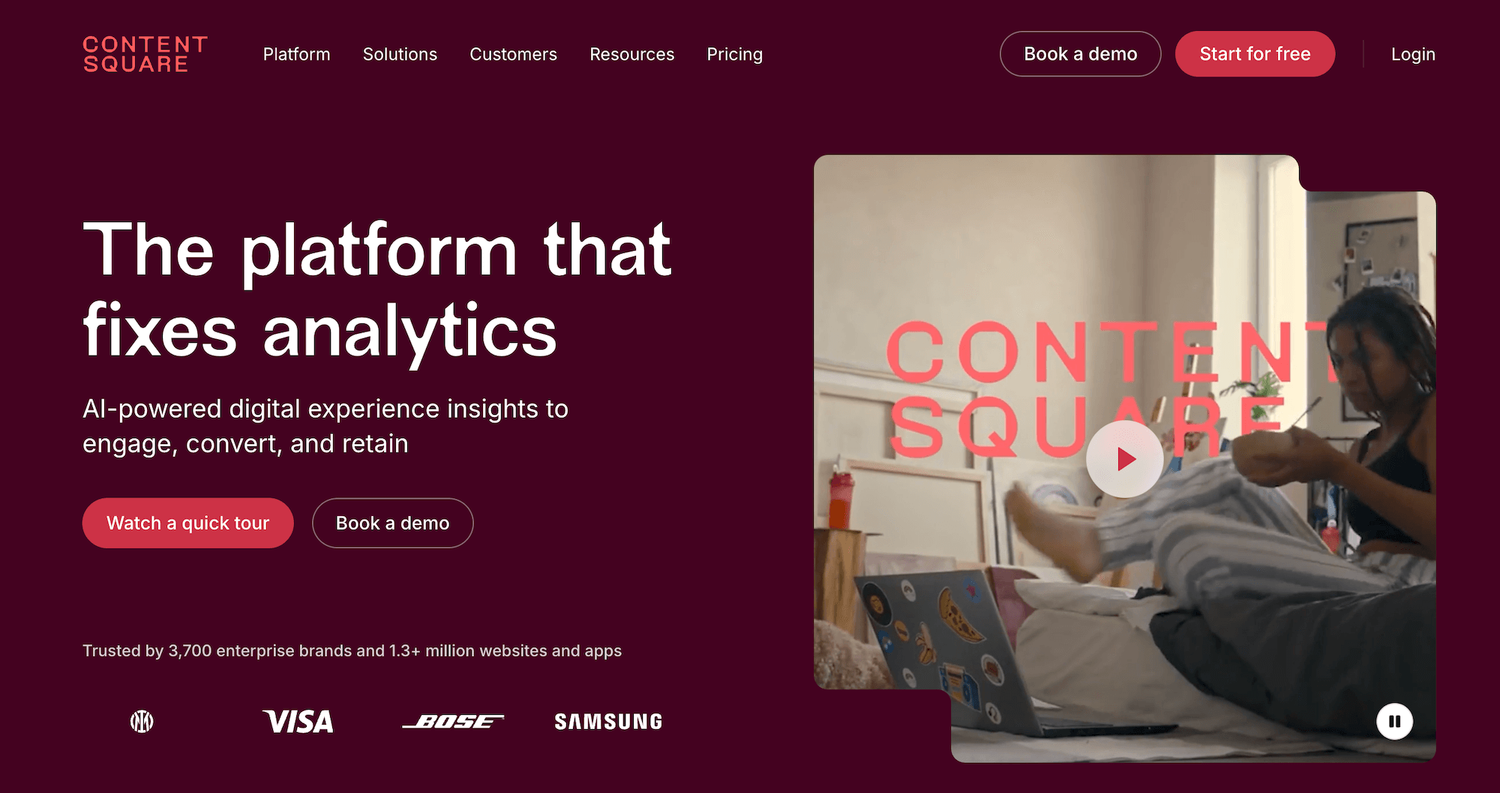
Contentsquare is a customer experience platform for businesses with digital products and services. It combines survey tools with heatmaps and session recording.
Contentsquare features include:
- A Voice-of-Customer platform that includes customer experience monitoring through surveys, including NPS
- Ability to explore customers’ interactions with digital products to see which UX issues may have contributed to the score
- AI support to build surveys and analyze survey responses
The tool offers a free plan for up to 5,000 monthly sessions, and paid plans start at $40 per month for up to 7,000 sessions.
4. Velaris
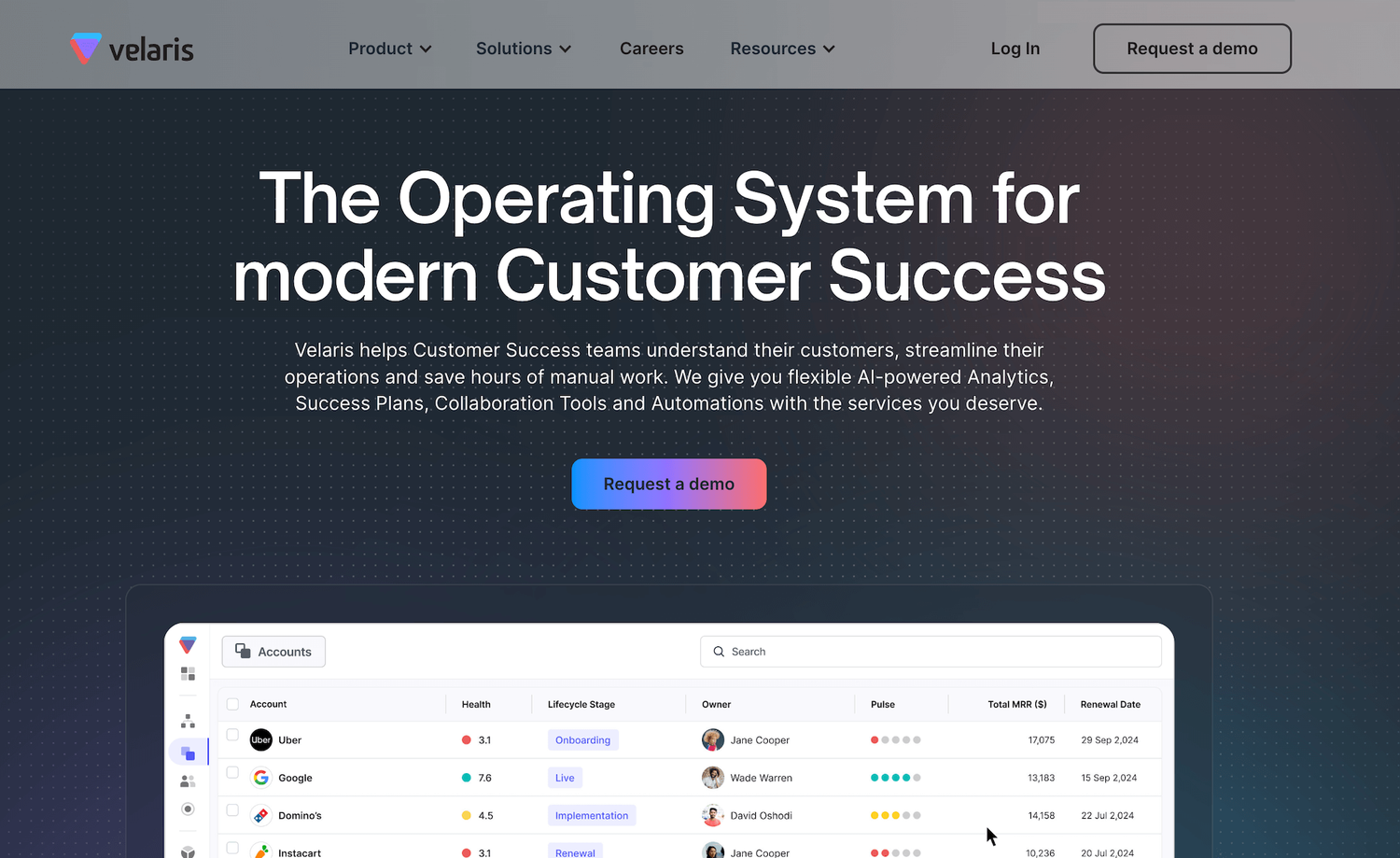
Velaris is a platform for customer success teams that includes survey tool capabilities to collect feedback (currently CSAT and NPS, with plans to add Customer Effort Score (CES) in the future). Other Velaris features worth mentioning include:
- Customer account health evaluation
- Automations and playbooks for more effective communications
- Customer portals for collaboration with customer teams
You have to contact Velaris’ team to get pricing information, as this isn’t shown on their website.
5. Simplesat
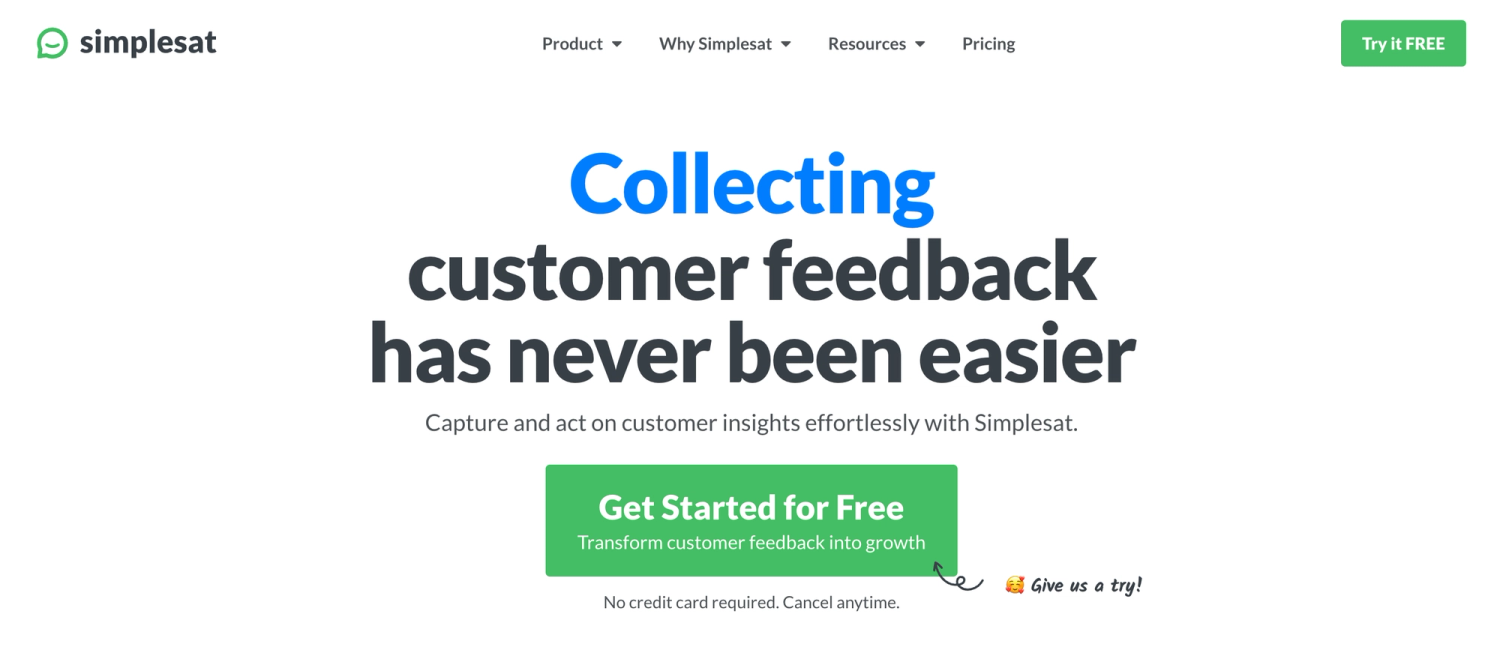
Simplesat is a customer satisfaction survey software for marketing and CS teams to gather customer feedback. Among other types of surveys, it offers NPS, CSAT and CES surveys to help measure satisfaction levels.
Simplesat features include:
- Customizable templates in an engaging format
- Direct integrations with Zendesk, ConnectWise, Autotask and Freshdesk, plus placeholder support for other helpdesks
- Advanced filtering and response-level drilldown in analytics
Pricing starts at $109 per month when billed annually, for five account users and up to 1,000 responses.
6. Nicereply
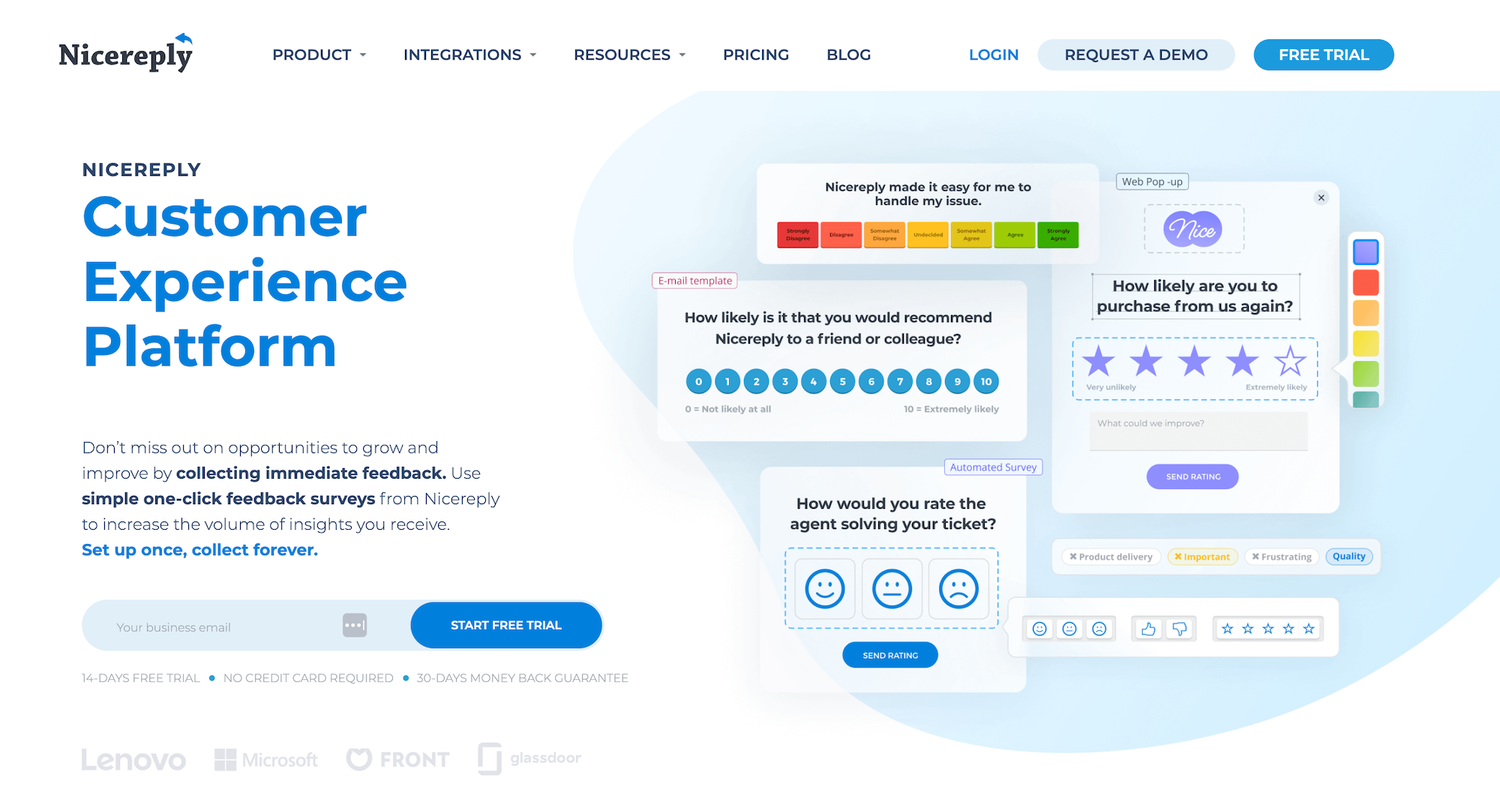
Nicereply is a customer experience platform built for customer support teams that offers NPS, CSAT and CES templates. It integrates with helpdesk tools, which makes it possible to enrich survey data and link back to support tickets that triggered the survey for valuable insights.
Nicereply features include:
- Automated triggers for sending out questionnaires
- Different ways to send out surveys, from links to website pop-up widgets and in-signature surveys in emails
- Auto-save for responses, including incomplete forms, and automated response import for analytics
Nicereply offers a free 14-day trial and a 30-day money-back guarantee. The paid plans start at $59 per month, for annual billing.
7. SurveySparrow
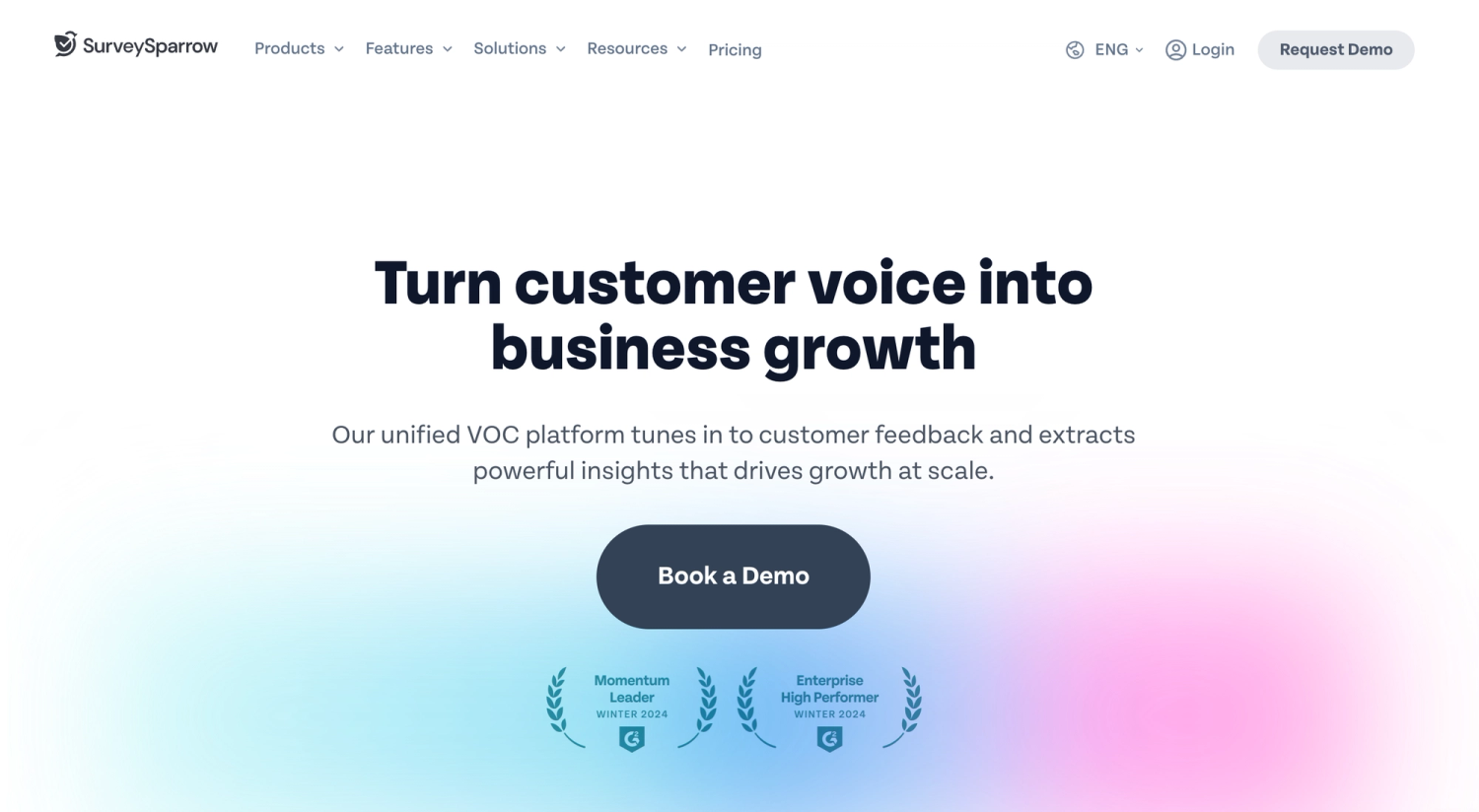
SurveySparrow is a survey tool that helps customer success teams gather feedback in ways that integrate with team workflows. Questionnaires created in this tool can be shared across channels, from text messages to embedded forms on websites, videos, and chatbots.
In addition, SurveySparrow offers the following features:
- Survey automation for ongoing feedback collection across touchpoints, including CSAT and NPS
- Ticket creation based on provided feedback for faster resolution
- Additionally, SurveySparrow allows teams to collect and analyze external feedback, such as online reviews, for reputation management
SurveySparrow requires sharing name, phone number, and email to unlock pricing data, and offers a 14-day free trial.
8. Survicate
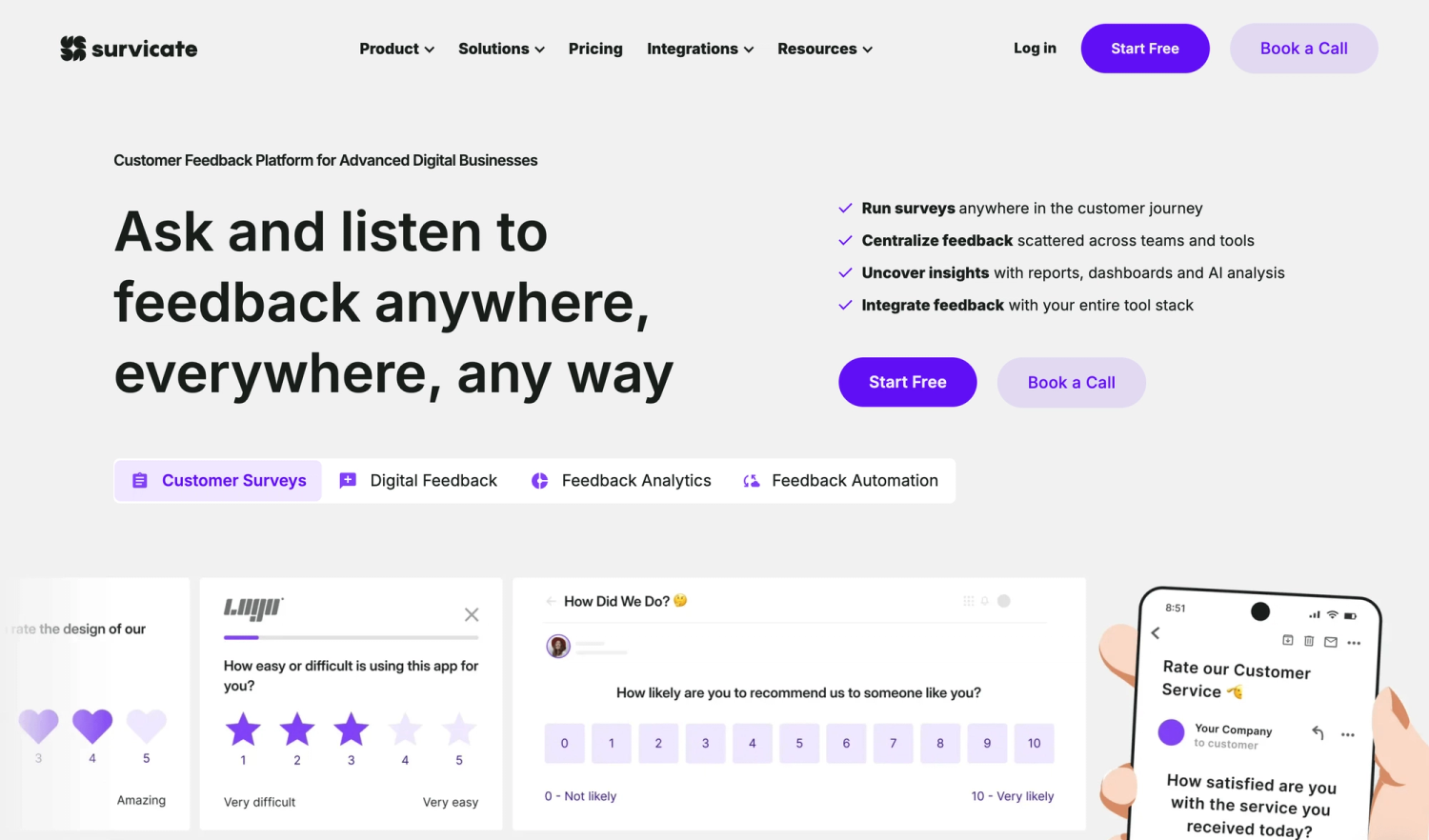
Survicate is a tool that automates CSAT surveys and analyzes them as they’re collected. It also integrates with additional products to trigger follow-up actions.
Features include:
- A variety of survey sharing options, from links to websites, mobile and emails and in-product and Intercom surveys
- Ability to capture even incomplete survey data and redirect survey participants after survey completion
- Automations for ongoing feedback collection
Survicate offers a free plan, with paid plans starting at $99 per month for up to 250 responses per month.
9. Typeform
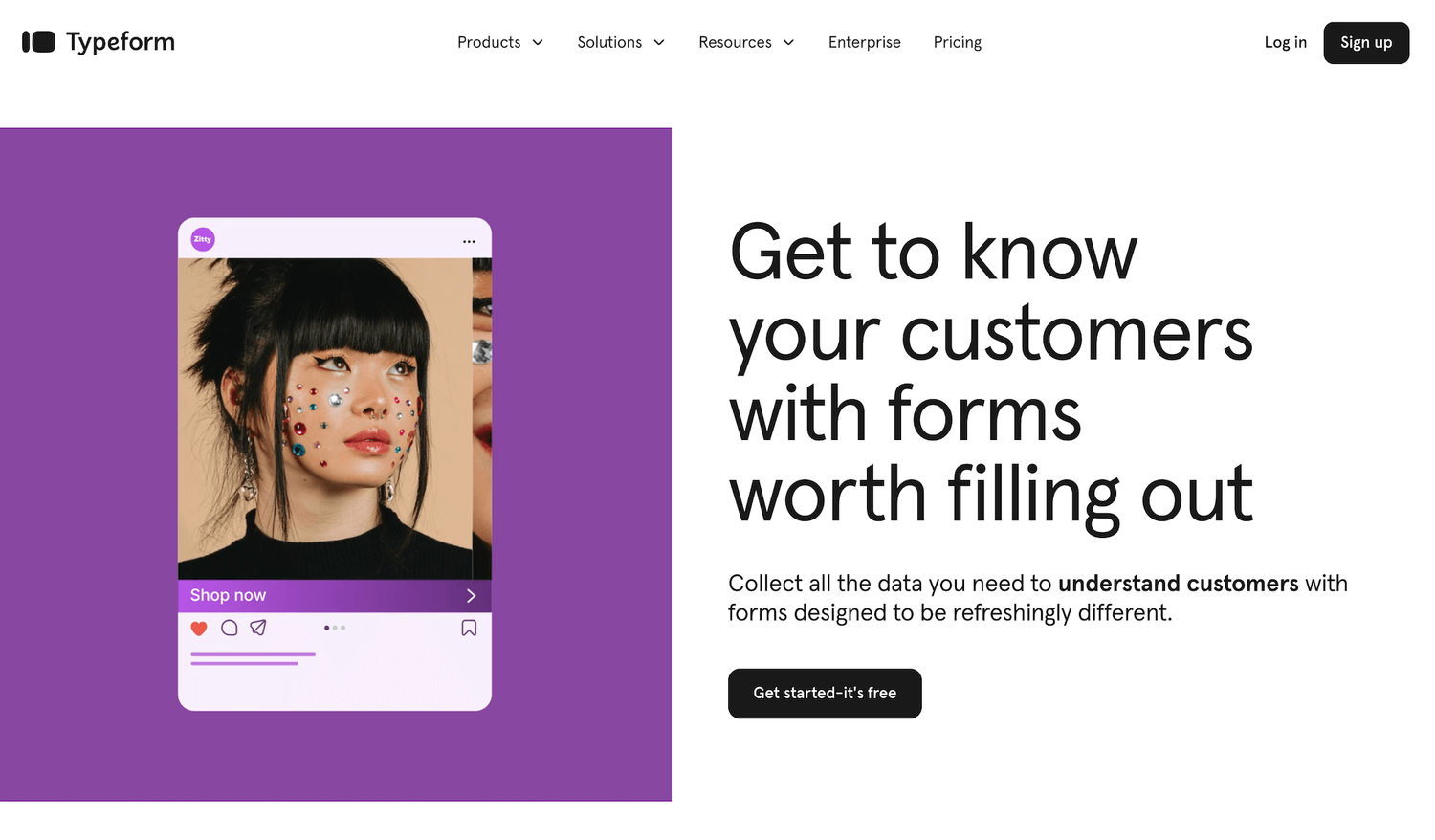
Typeform is a survey software built to create forms that encourage higher response rates through design and custom logic. It can be used for market research and customer feedback surveys, including CSAT and NPS.
Typeform features include:
- Pre-built templates and customizable templates with AI support for form design
- Ability to share or embed surveys on multiple channels
- Integrations with CMS, email marketing, file management tools, and more
Typeform offers a free plan, with paid plans starting at $25 per month for a yearly subscription.
10. Jotform

Jotform is a survey tool that offers a variety of options to collect information about customer needs. It can be used for customer and prospect research and as a way to collect payments and sign contracts.
Jotform features include:
- An extensive template library, including customer satisfaction survey forms
- Workflows to automate tasks and export submissions
- Integrations with CRM, marketing and sales platforms, plus file sharing and storage products
It offers a free starter plan. Paid plans start at $34 per month, billed annually.
11. SurveyMonkey
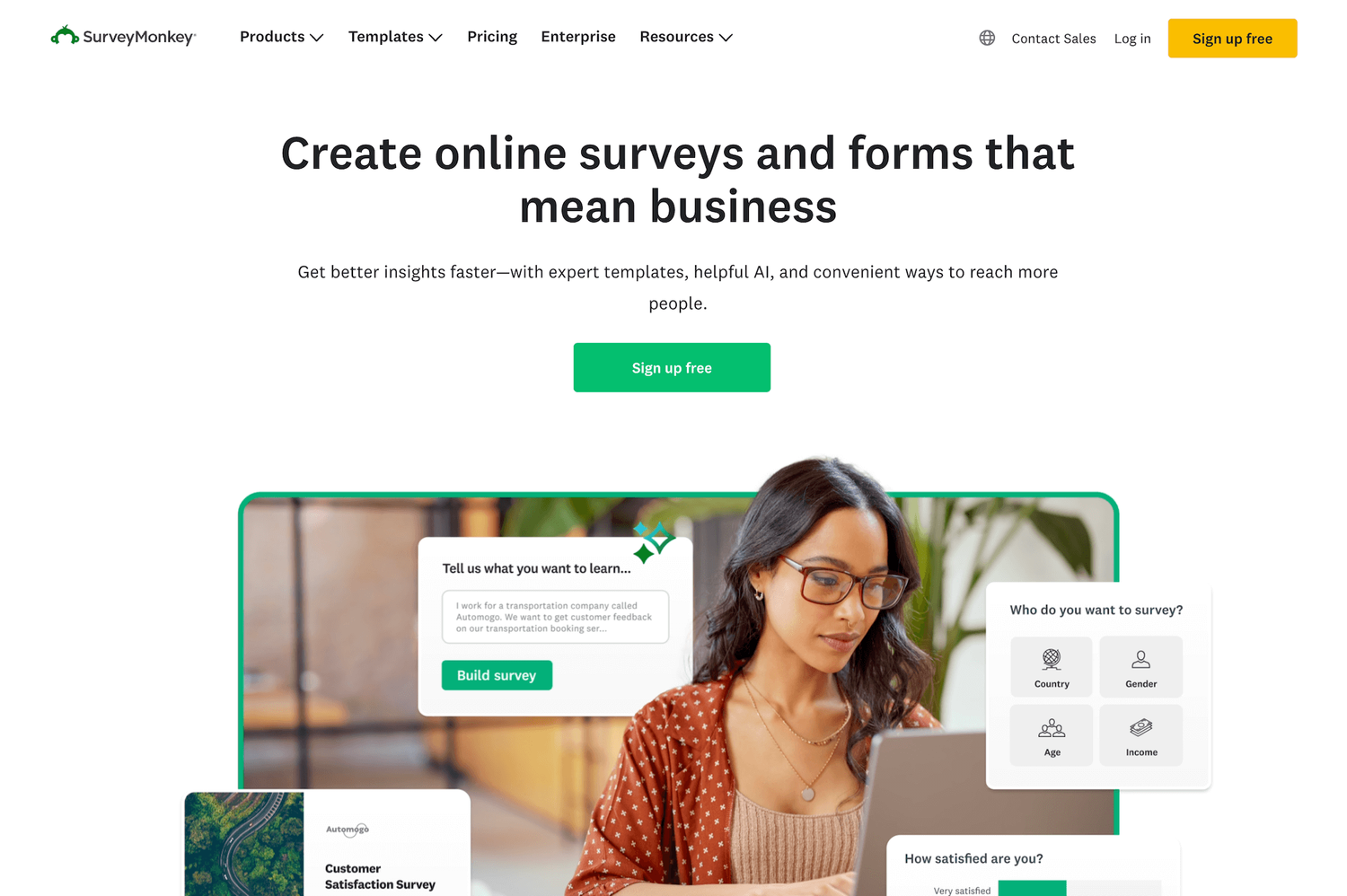
SurveyMonkey is a tool that can be used by CX teams to run both CSAT and NPS questionnaires, as well as customer experience surveys with different question types and custom logic.
SurveyMonkey key features include:
- Pre-built templates and customizable templates
- Multi-channel launch options, including links, forms, social media posts, email surveys, and more
- Integrations with sales and customer support platforms and data visualization tools, such as Salesforce, Zendesk, and Tableau
SurveyMonkey offers a free plan as well as individual and team plans, starting at $199 per month and $25 per user per month, respectively.
12. Refiner
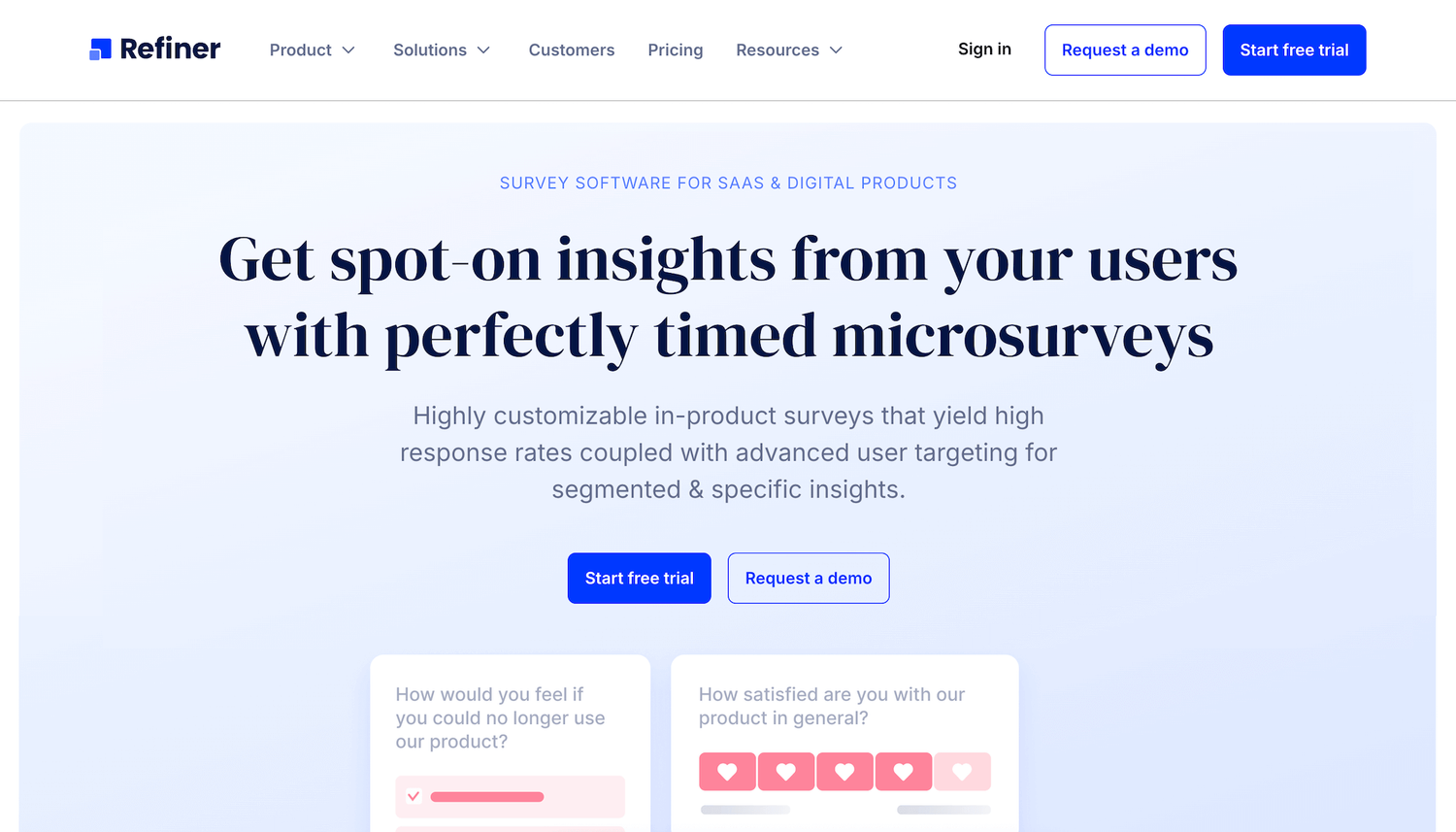
Refiner is a survey tool for web and mobile product companies, such as SaaS, Fintech and a variety of marketplaces. It allows you to create many different forms, including CSAT and NPS.
Refiner features include:
- Multi-channel surveys, such as in-app, web, and mobile
- Customizable templates and survey designs, including microsurveys
- The ability to import events from other tools like Segment or Rudderstack
Refiner offers a free trial and the plans start at $79 a month for 5,000 users.
Schedule Your Level AI Demo Today
Level AI raises customer satisfaction using analytics to uncover gaps in your service and reveal opportunities to improve CX.
Book a demo with our team to learn how Level AI’s comprehensive customer satisfaction tracking and analysis can work for you.
Keep reading
View all

